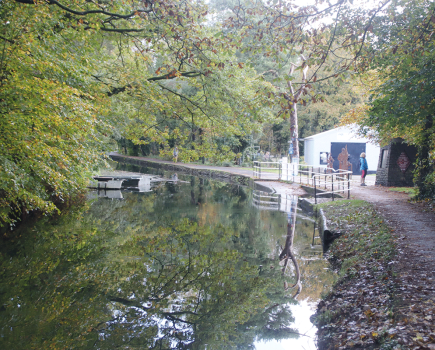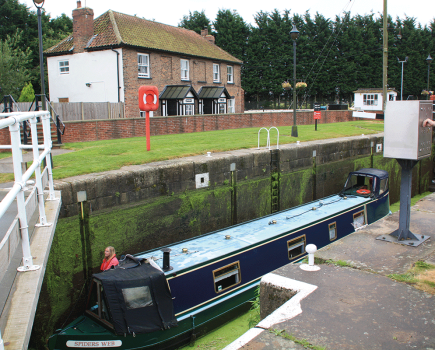Words and images by Fiona Slee
The Bridgewater Canal is among our favourite canals. Originally built for broadbeam cargo boats, it is deep, wide and well maintained, which is partly why we like it so much.
The Duke of Bridgewater built it because he was frustrated by the high cost of pack horse transport from his mines into Manchester. A canny businessman, he began to charge tolls and so made his money back, as well as halving the price of coal. Deliveries were speeded up and the canal was eventually linked to other canals by its engineer, James Brindley. It was perhaps the first canal not to follow an existing waterway and it was, as you probably know, his vision that began the ‘Canal Age’. Francis Egerton, the Duke of Bridgewater, has been rightly called The Father of Canals, and we owe him a debt of gratitude in more ways than one.
The first section of the Bridgewater Canal from Worsley to Manchester terminated in Castlefield Basin. The canal was later extended to Runcorn and met the Trent & Mersey at Preston Brook.
The ownership has transferred from aristocracy to giant conglomerate, from personal gain to modern commerce. It is now owned and operated by the Manchester Ship Canal Company, together with the Bridgewater Canal Trust which represents local authorities along the line. The Manchester Ship Canal Company is part of the Peel Ports Group, owned by Manchester based Peel Holdings Ltd, one of the UK’s largest property and transport companies.
British Waterways licence holders like us are encouraged to stay no longer than seven days. Boats based on the canal require a Bridgewater Canal Licence from the Manchester Ship Canal Company.
We began our cruise from Manchester’s Castlefield Basin where, while it has probably changed much since the Duke’s day, some of the warehouses and wharves remain as testimony to the canal transport age.
The Bridgewater Main Line from Manchester runs alongside the Manchester Ship Canal, the railway and the tram line, so there is plenty to see. However, it’s not the prettiest of sections, passing old warehouses and docks, old Hulme Lock onto the Manchester Ship Canal, and Pomona Lock, the current lock down.
At Waters Meeting, the Bridgewater Main Line travels south-west towards Runcorn and the Trent & Mersey Canal at Preston Brook. We turned onto the Bridgewater Leigh Branch going north-west towards Worsley and the Leeds & Liverpool. The carriage of freight ceased in 1974 and the canal has found new leisure uses forming part of the Cheshire Ring. I could smell Rice Krispies as we passed the sprawling Kellogg’s factory and the old arm that used to serve the factory.
The Trafford Centre, a huge shopping mall, was built on the land of a large industrial estate known as Trafford Park with factories, a mill and grain silos together with wharves serving the Manchester Ship Canal. There are moorings here if a bit of retail therapy is required.
Passing an incongruous canal-side pagoda and moorings, we arrived at Barton Aqueduct, built in 1893. It is impressive, if a little shabby. The aqueduct crosses the Manchester Ship Canal and mirrors the swing road bridge alongside. The Bridgewater Canal originally crossed the River Irwell around here on a stone aqueduct built by James Brindley. When the Manchester Ship Canal was built, the river was incorporated and the Barton Swing Aqueduct replaced the stone one, to allow large ships through. Both the swing road bridge and aqueduct are controlled from the central tower.
We passed a large tug-style boat which had a problem – a mattress had caught around its propeller and two men were in the water trying to free it. We wouldn’t have liked such a large object to get caught around ours and, as requested by the crew, we crept by.
Worsley is a useful place to stop – the moorings are pleasant and there is plenty of history to discover. The canal water here is brown from the iron ore seeping into the canal. What remains of The Duke’s coal mines are nearby. The entrance tunnels, where small coal boats known as ‘starvationers’ used to navigate right into the mines to load, can be seen at The Delph, just a short walk away.
The well known mid-18th Century Packet House is Grade II listed. Passenger services began in 1769 and eventually there was a daily service between Manchester, Runcorn and Worsley. You bought your ticket at the Packet House and boarded the Packet Boat at the steps. The boats were built for speed. Drawn by three horses, a postillion, armed with spurs and a whip, blew his horn as a warning. He meant business! In 1843, for 3d (1p for anyone born after decimalisation), you could ride first class at speeds up to 6mph! It must have been some sight.
After lunch, we moved off towards Astley. The canal-side industries have long disappeared and the canal now passes through open country and the large peat bog, Chat Moss. Looking carefully, you can spot clues to the past though. The pit head wheel at Astley Colliery Museum can be seen for quite a while and there is the remains of an old coal wharf on the canal.
We continued on to Leigh – an old mill town with remains of mills still visible beside the canal. It was fustian, cotton and silk that made Leigh’s name. Five of the multi-storey spinning mills of the mid-1880s are still standing.
At the west end of Leigh we cruised onto another canal. Strangely, without a fuss, stop lock or junction, the Leigh Branch of the Bridgewater Canal becomes the Leigh Branch of the Leeds & Liverpool Canal at Leigh Bridge 66 (Bridgewater Canal numbering) or Bridge 11 (Leeds & Liverpool Canal numbering).
After all the industry of Leigh, once we passed under this bridge, it was a relief to be out in the countryside again and leave ‘The Duke’s Cut’ behind for the Leeds & Liverpool Canal towards Wigan.







